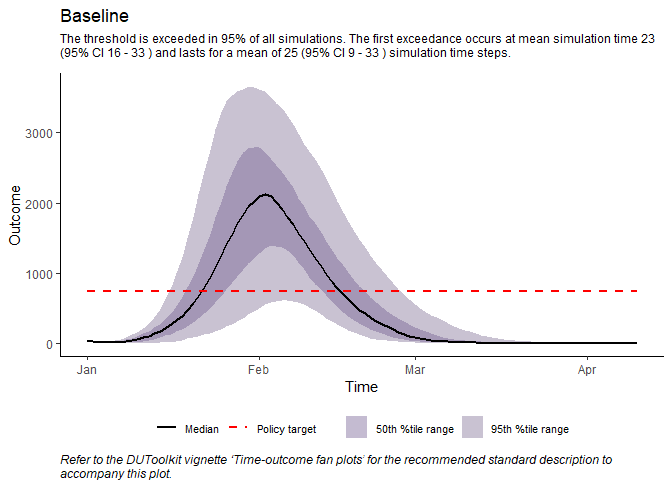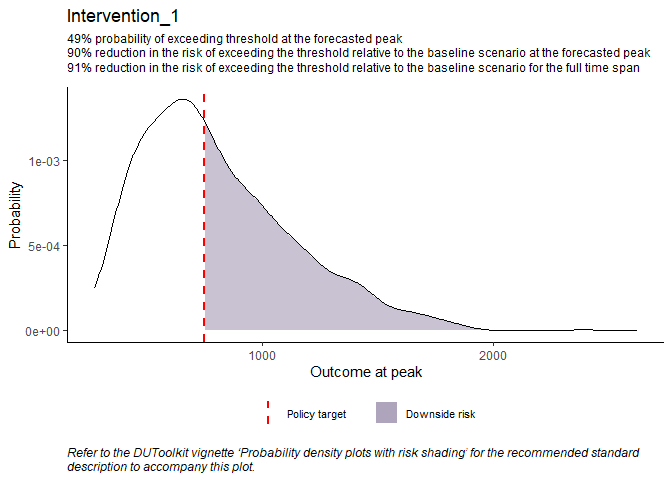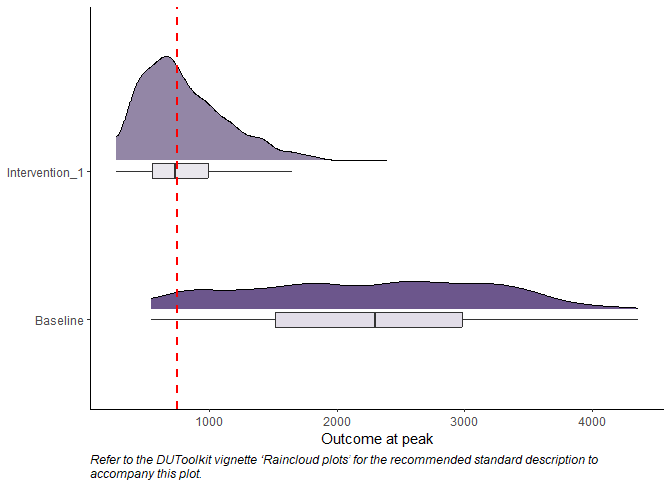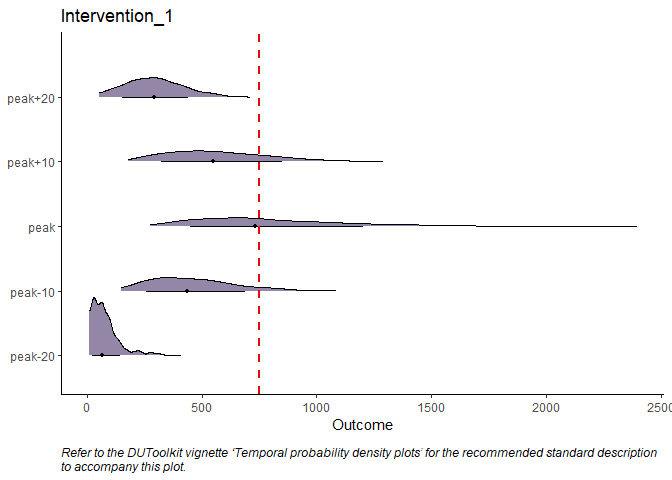

The DUToolkit package provides a suite of tools and visualization for the characterization, estimation, and communication of parameter uncertainty and decision risk. The package is designed to evaluate the impact of policy alternatives on outcomes compared to baseline (i.e., counterfactual analysis), leveraging model outputs from uncertainty analysis. See Wiggins et al. (2025) for a full description of the underlying methods.
During public health crises such as the COVID-19 pandemic, decision-makers relied on models to predict and estimate the impact of various policy alternatives on health outcomes. Often, there is a high degree of uncertainty in the evidence base underpinning these models. When there is increased uncertainty, the risk of selecting a policy option that does not align with the intended policy objective also increases; we term this decision risk. Even when models adequately capture uncertainty, the tools used to communicate their outcomes, underlying uncertainty, and the associated decision risk are important to mitigate decisions to adopt sub-optimal policies and/or critical health technologies.
You can install the ‘DUToolkit’ package from CRAN with the following command in the console:
install.packages("DUToolkit")library(DUToolkit)
# calculate risk measures
tmin <- "2021-01-01"
tmax <- "2021-04-10"
Dt <- rep(750, nrow(psa_data$Baseline))
risk_measures <- calculate_risk(
psa_data,
tmin = tmin,
tmax = tmax,
Dt = Dt,
Dt_max = TRUE
)
tabulate_risk(risk_measures, n_s = 2)
#> Baseline Intervention 1
#> Risk "23078.21" "2007.47"
#> Policy risk impact "-" "-91.30%"# generate fan plots
fan_plots <- plot_fan(
psa_data,
tmin = tmin,
tmax = tmax,
Dt = Dt,
Dt_max = TRUE
)
## example plot
fan_plots$Baseline
## find peak values
peak_values_list <- get_max_min_values(
psa_data,
tmin = tmin,
tmax = tmax,
Dt_max = TRUE
)
head(peak_values_list$Baseline)
#> N outcome i_time
#> 1 1 4207.443 2021-01-26
#> 2 2 1681.521 2021-02-01
#> 3 3 2539.177 2021-02-04
#> 4 4 2969.721 2021-01-31
#> 5 5 3073.741 2021-02-05
#> 6 6 1520.144 2021-02-08# define single threshold value for the peak (D)
D <- 750
# generate density plots
density_plots <- plot_density(
peak_values_list,
D = D,
Dt_max = TRUE,
risk_measures
)
## example plot
density_plots$Intervention_1
# define vector of threshold values
Dp <- c(750, 1000, 2000)
# calculate probability that peak value is > specified threshold values
peak_probs <- calculate_threshold_probs(
peak_values_list,
Dp = Dp,
Dt_max = TRUE
)
peak_probs$Baseline
#> 750 1000 2000
#> 0.9494 0.8887 0.5895# calculate risk measures at peak values
peak_risk <- calculate_max_min_risk(
peak_values_list,
D = D,
Dt_max = TRUE
)
# generate risk table dataframe
tabulate_risk(peak_risk, n_s = 2)
#> Baseline Intervention 1
#> Risk "1500.79" "156.52"
#> Policy risk impact "-" "-89.57%"# generate raincloud plot
plot_raincloud(
peak_values_list,
D = D
)
# define time step variables
t_s <- 20 # the total number of timesteps from the peak
t_ss <- 10 # the timestep increments
# find values for temporal density plots
peak_temporal_list <- get_relative_values(
psa_data,
peak_values_list,
t_s = t_s,
t_ss = t_ss
)
head(peak_temporal_list$Baseline[[1]])
#> time outcome N
#> 1 peak 4207.443 1
#> 2 peak 1681.521 2
#> 3 peak 2539.177 3
#> 4 peak 2969.721 4
#> 5 peak 3073.741 5
#> 6 peak 1520.144 6# generate peak temporal density plots
peak_temporal_plots <- plot_temporal(
peak_temporal_list,
D
)
## example plot
peak_temporal_plots$Intervention_1
# generate summary statistics for peak temporal data
stats_peak_temporal <- sum_stats_temporal(peak_temporal_list)
stats_peak_temporal$Baseline
#> time_step n q1 median mean q3
#> 1 peak-20 813 90.32 136.99 157.21 210.21
#> 2 peak-10 813 738.29 1013.14 1005.52 1260.49
#> 3 peak 813 1520.14 2300.14 2247.85 2982.81
#> 4 peak+10 813 884.80 1246.00 1211.20 1548.80
#> 5 peak+20 813 247.77 326.34 338.76 418.55We would like to thank everyone whom we engaged with including workshop participants for their feedback on the Decision Uncertainty Toolkit.